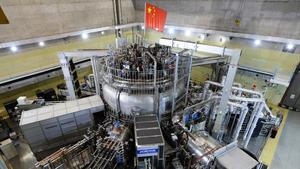 The photo shows the Experimental Advanced Superconducting Tokamak (EAST) in Hefei, East China's Anhui province, which is dubbed as "artificial sun", Aug 16, 2018. (PHOTO / IC)
The photo shows the Experimental Advanced Superconducting Tokamak (EAST) in Hefei, East China's Anhui province, which is dubbed as "artificial sun", Aug 16, 2018. (PHOTO / IC)
After thousands of nuclear fusion experiments, Chinese scientists made a big breakthrough on May 28 in their quest to create an artificial sun that could help solve the world's energy problems.
They set a record for sustained heat in nuclear plasma-a temperature of 120 million C for 101 seconds-said Gong Xianzu, a physicist in charge of the experiment in Hefei, Anhui province.
Gong, a leading researcher at the Institute of Plasma Physics in Hefei, said on Tuesday that the result at the Experimental Advanced Superconducting Tokamak, or EAST-nicknamed the "Chinese artificial sun"-also reached a temperature of 160 million C for 20 seconds.
A tokamak is a device that uses a powerful magnetic field to confine a nuclear reaction. It is one of several types of magnetic confinement devices being developed to produce controlled thermonuclear fusion power. The technology is said to be the leading candidate for a practical fusion reactor.
"The experiments try to simulate the nuclear fusion reaction that happens in the sun," said Gong, who joined the research 30 years ago.
A tokamak is a device that uses a powerful magnetic field to confine a nuclear reaction. It is one of several types of magnetic confinement devices being developed to produce controlled thermonuclear fusion power. The technology is said to be the leading candidate for a practical fusion reactor
ALSO READ: China commissions new-generation 'artificial sun'
Although the temperature at the core of the sun is relatively cool-about 15 million C-the density of plasma, which consists of ions and free electrons, is high enough to generate a sustained reaction.
In a fusion reaction, two or more atomic nuclei are combined to form one or more different atomic nuclei and subatomic particles. Theoretically, the process can produce massive amounts of clean, safe energy that could be manipulated in a nuclear reactor.
On Tuesday, scientists and engineers were continuing the experiment for the 99,145th time using the doughnut-shaped tokamak-which has a vacuum system, radio frequency wave system, laser scattering system and microwave system-a technical introduction that was explained, after they made the breakthrough at their 98,958th attempt on Friday.
Gong said the ultimate goal of the team's research is to create the necessary conditions for a fusion reactor.
"If we compare the tokamak facility to the engine of a car, then the reactor is akin to the vehicle as a whole," he said, adding that a vehicle is normally built for road tests before finally finding commercial use.
Ground was broken at the end of 2018 for construction of a fusion reactor-known as the Comprehensive Research Facility for Fusion Technology-in the outskirts of Hefei's Luyang district. The infrastructure is nearly complete, according to recent media reports.
READ MORE: 'Chinese artificial sun' sets new world record
The CRAFT website says construction will take five years and eight months.
"Challenges in the ongoing research come from two areas," Gong said. "We need to create the necessary conditions in which a fusion reaction can occur and meanwhile overcome a lot of engineering difficulties to make the reaction absolutely controllable."
He said the test reactor, which is still in the initial design phase, will use deuterium, a hydrogen isotope-a varied form of hydrogen with twice its atomic mass-that is abundant in the sea, to provide a steady stream of clean energy.
"We estimate that the deuterium in 1 liter of seawater can pro-duce through a fusion reaction the amount of energy produced by 300 liters of gasoline," he said.
Gong expressed hope that the reactor would be ready in the near future so he can personally witness it playing a major role in fulfilling China's commitment to achieving carbon neutrality before 2060. He said that in 2006 he witnessed the launch of the tokamak facility in Hefei, which was the first of its kind.
The fusion reactor will be an internationally open platform for scientists from around the world, according to the CRAFT website.
Randy Wright contributed to this story.


